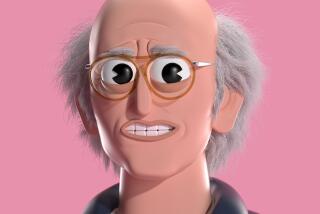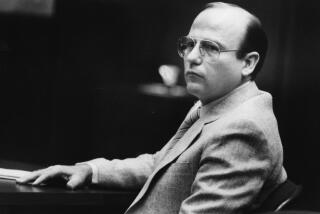‘Timothy Leary’s’ Fascination Falters
- Share via
The details of Timothy Leary’s death last year of prostate cancer are more known than such details usually are. Leary considered death the last of what he called the three big taboos (the preceding two being sex and drugs), so he made a point of flaunting the conventions that normally attend it. An unconventional man whose compulsive defiance of authority may have been his greatest gift to society, Leary is such a rich biographical subject that one senses the shortcomings of “Timothy Leary’s Dead” all the more.
The directorial debut of Paul Davids who conducted extensive interviews with Leary in the final months of his life, the film purports to be a biography but fails miserably in that regard. We get no sense whatsoever, for instance, of the forces that shaped Leary into the man he became. Why did his four marriages and his relationships with his children fail? The film refers to the myriad books Leary wrote, but what precisely were the books about? What, in Leary’s opinion, was the final legacy of the social revolution he helped launch in the ‘60s? Was anything of lasting value achieved, or was it merely a blip of freedom on the radar screen of societal control? You won’t find answers to these questions in Davids’ confusing film, which scrambles the chronology of events in Leary’s life and lacks a clear narrative arc.
Davids is, of course, to be commended for having the foresight to capture Leary at length on film as his life wound to a close. Leary, seen as a 75-year-old man who was clearly gravely ill, remained remarkably articulate to the end--all that LSD didn’t seem to have hurt him. Davids also did a terrific job of tracking down archival footage and still photos and conducted sharp interviews with Leary’s colleagues from his days at Harvard--Richard Alpert (a.k.a. Ram Dass) and Ralph Metzner--both of whom have insightful things to say about Leary.
However, the film completely unravels in its final half hour, which includes an interview with a police officer expounding on the dangers of drug use, a clip from a cartoon, interviews with members of a Bay Area nudist organization, shots of Leary’s mailbox, a mosh pit at L.A. club Jabberjaw, an acquaintance of Leary’s taking a hit off a bong and musicians on the Venice boardwalk performing a song co-written by Davids. None of this adds to our understanding of Leary, nor is it of interest on any other score.
*
The film takes its final misstep in its handling of the cryogenics question that hovered over Leary’s death. Several years ago Leary arranged to have his brain cryonically frozen for future thawing and use, but three weeks prior to his death he announced he was canceling the procedure. Davids’ film concludes with a scene that suggests Leary is undergoing some sort of surgical procedure and then cuts to a shot of what may or may not be Leary’s head packed in ice.
Davids won’t divulge whether the scene was faked, but the closing credits roll over footage of Leary having a plaster cast made of his head. Whatever the truth of the matter, this is a tacky way to bring the curtain down on Leary’s life. Love him or hate him, Leary was a repository for many American dreams and nightmares of the last 50 years, and the “cryonics mystery” trivializes all he represents.
* Unrated. Times guidelines: some drug use and nudity.
‘Timothy Leary’s Dead’
A Strand Releasing presentation featuring Timothy Leary, Richard Alpert and Ralph Metzner. Director Paul Davids. Producers Paul Davids and Todd Easton Mills. Screenplay Paul Davids and Todd Easton Mills. Cinematography by Paul Helling. Editor David J. Wilson and Mark Deimel. Running time: 1 hour, 20 minutes.
* At the Sunset 5, 8000 Sunset Blvd., West Hollywood, (213) 848-3500; Monica 4-Plex, 1332 2nd St., Santa Monica, (310) 394-9741; Los Feliz 3, 1822 N. Vermont, (213) 664-2169; Town Center, 3199 Park Center Drive, Costa Mesa, (714) 751-4184.
More to Read
Only good movies
Get the Indie Focus newsletter, Mark Olsen's weekly guide to the world of cinema.
You may occasionally receive promotional content from the Los Angeles Times.










